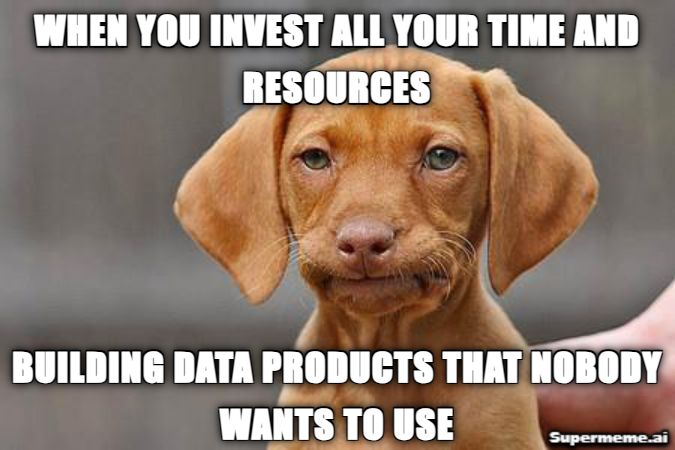Building a Data Product Ecosystem with Human-Centric Design
Traditionally, data management has not focused on the end users. Many organizations approach data with a siloed, producer-centric mindset, where the primary goal is to build a data platform, centralize as many data sources as possible into a data warehouse or lake-house, and focus on data production. The needs of the business user, such as the ability to create their own data analytics on the fly to respond swiftly to business problems and opportunities, often take a back seat.
Generating actual business value from a chaotic jumble of raw data requires deep expertise, months-long wrangling, and distracting back and forth between business teams and central data teams. Meanwhile, business teams watch opportunities slip by, hamstrung by their dependence on hyperspecialized central data teams.
Empowering Business Teams with Self-Serve Data Products
Business teams need the capability to directly create data products to solve business problems without lengthy intermediate steps. The missing ingredient is user experience (UX). UX is integral to data products, combined with just-in-time data architecture, enabling business users to create powerful analytics in seconds, completely disrupting the limits of existing approaches.
To achieve this, we need to focus on four key pillars:
Human Usability and User Needs
Human usability and user needs must be front and center, not producer convenience. This requires a shift in mindset from viewing data as a separate entity managed by a central team to a valuable resource that can be actualized for business use. The goal is to create data products that business users can easily interact with, ensuring that their needs are prioritized over the convenience of data producers.
It's essential to move beyond asking end-users "what do you need from data and analytics" and focus on understanding what they'll actually use. Business users often default to familiar metrics or tools like exporting to Excel, despite the availability of more advanced analytics solutions. Part of the UX approach needs to include demonstrating the art of the possible while leading with a genuine business outcome conversation to deeply understand their goals, even if they can’t articulate them well.
Low-Code Marketplace for Self-Service
Create a low-code marketplace offering frictionless self-service access to the creation and consumption of high-quality data products. This means moving away from centralized data warehouses run by central engineering teams and towards a federated, decentralized, and decoupled architecture, such as a data mesh. This approach empowers business users to build and manage their own data products with minimal technical expertise, enabling faster and more efficient problem-solving.
Adoption of any new behavior is change by default. Understanding how business users reacted to previous changes and what they changed themselves can help in predicting the trade-offs they are willing to make. This iterative process with continuous feedback can significantly enhance the adoption and effectiveness of new data products.
Personalized UX for Different User Personas
UX must be personalized for different users, catering to the workflows suited to the skills and needs of diverse user personas, including analysts, scientists, and tech-savvy business users. This personalization allows users to experiment, build, and iterate data products autonomously. By tailoring the UX to different user types, we can ensure that each user has the tools and interfaces they need to be productive and effective.
The importance of UX is highlighted by the fact that many business teams lack the logic needed to become effective data citizens. Democratization increases individual participation and accountability, but it also brings saturation of systems and performance stress, which can be challenging to manage. Simplifying UX and providing user-friendly interfaces can make interacting with data and analytics accessible to a broader audience, not just technical experts.
Designing Impeccable UX Alongside Technical Aspects
Impeccable UX must always be designed alongside the technical aspects of a data product. You can build a technically excellent data product, but if the UX doesn’t match how users want to work or meet their level of data sophistication, they won’t use it, and it won’t produce business value. Similarly, spending months designing an aspirational user-centric data product with fancy personalized dashboards and visualizations, only to find out that it’s prohibitively expensive or time-consuming to plug the right data in, is equally ineffective. The solution is to build out both in tandem, ensuring that technical excellence and user-centric design go hand in hand.
Creating a Human-Centric, Self-Service Data Ecosystem
The result is a fully human-centric, self-service, low-code marketplace that directly connects your people on the front line with the vehicle of business value—the data product—massively reducing time-to-market and multiplying agility many times over.
Conclusion
Building data products with a focus on UX ensures that they are not only technically excellent but also user-friendly and aligned with how users want to work. By prioritizing human usability, creating a low-code marketplace, personalizing UX for different personas, and designing impeccable UX alongside technical aspects, organizations can create a human-centric, self-service data ecosystem. This approach empowers business teams to solve problems quickly and efficiently, driving business value and agility.
UX matters because it bridges the gap between data potential and data usability, making it possible for business users to unlock the full value of their data products.


